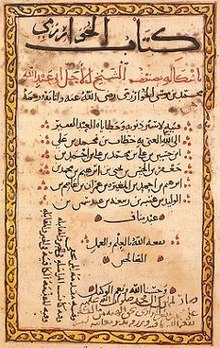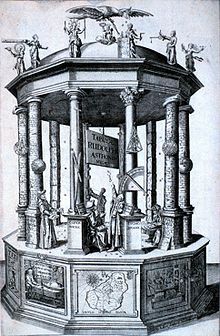用户:Xreedl/Sandbox1

| 科学史 |
|---|
 |
|
数学起源于人类早期的生产活动,为古中国六艺之一,亦被古希腊学者视为哲学之起点。数学的希腊语μαθηματικός (mathematikós)意思是“学问的基础”,源于μάθημα (máthema)(“科学,知识,学问”)。
数学最早用于人们计数、天文、度量甚至是贸易的需要。这些需要可以简单地被概括为数学对结构、空间以及时间的研究。
对结构的研究是从数字开始的,首先是从我们称之为初等代数的——自然数和整数以及它们的算术关系式开始的。更深层次的研究是数论。
对空间的研究则是从几何学开始的,首先是欧几里得几何和类似于三维空间(也适用于多或少维)的三角学。后来产生了非欧几里得几何,在相对论中扮演著重要角色。
到了16世纪,算术、初等代数及三角学等初等数学已大体完备。17世纪变数概念的产生使人们开始研究变化中的量与量的互相关系和图形间的互相变换。随著自然科学和技术的进一步发展,为研究数学基础而产生的集合论和数理逻辑等也开始慢慢发展。
数学史研究主要专注于诸多数学发现和理论的起源,其次是过去的数学方法和标记法。
近代以前,人类知识尚未能在全球范围内自由传播,数学领域的新发现只能在小范围内靠纸笔相传。现在还存世的最早的数学文本是Plimpton 322(巴比伦数学,公元前1900年),[1]莱因德数学纸草书(埃及数学,公元前2000-1800年)[2] 和莫斯科数学纸草书 (古埃及数学,公元前1890年)。所有这些文本的内容都与勾股定理相关——它几乎是基础算术和几何的框架形成之后最古老和最广为人知的数学发现。
古希腊数学为数学方法的改善和精炼做出了巨大贡献,不仅在演绎推理的引进和数学证明的严谨性提高上,还扩展了数学研究对象的范围。[3] 数学研究作为一个独立的学科开始出现是在公元前六世纪,其归功于毕达哥拉斯学派:他们根据古希腊语μάθημα(mathema)创造了术语“mathematics”,意思是“学科之基础”("subject of instruction")。[4] Chinese mathematics made early contributions, including a place value system.[5][6] The Hindu-Arabic numeral system and the rules for the use of its operations, in use throughout the world today, likely evolved over the course of the first millennium AD in India and was transmitted to the west via Islamic mathematics.[7][8] Islamic mathematics, in turn, developed and expanded the mathematics known to these civilizations.[9] Many Greek and Arabic texts on mathematics were then translated into Latin, which led to further development of mathematics in medieval Europe.
From ancient times through the 中世纪, bursts of mathematical creativity were often followed by centuries of stagnation. 从16世纪的意大利文艺复兴时期开始,new mathematical developments, interacting with new scientific discoveries, were made at an increasing pace that continues through the present day.
史前数学
[编辑]古代近东
[编辑]两河流域
[编辑]埃及
[编辑]古希腊
[编辑]中国
[编辑]印度
[编辑]伊斯兰世界
[编辑]中世纪欧洲
[编辑]中世纪早期
[编辑]复兴
[编辑]早期现代欧洲数学
[编辑]十七世纪
[编辑]十八世纪
[编辑]十九世纪
[编辑]二十世纪
[编辑]二十一世纪
[编辑]数学的未来
[编辑]参见
[编辑]参考文献
[编辑]延伸阅读
[编辑]外部链接
[编辑]期刊
[编辑]索引
[编辑]算数代数时代
[编辑]几何时代
[编辑]函数分析时代
[编辑]微积分时代
[编辑]微积分时代的开始,代表人类的数学进入了新的纪元,这是人类历史上化时代的进步。 数学研究方向产生历史:
相关条目
[编辑]外部链接
[编辑]- (中文)数学史--Episte Math
- ^ J. Friberg, "Methods and traditions of Babylonian mathematics. Plimpton 322, Pythagorean triples, and the Babylonian triangle parameter equations", Historia Mathematica, 8, 1981, pp. 277—318.
- ^ Neugebauer, Otto. The Exact Sciences in Antiquity 2. Dover Publications. 1969 [1957]. ISBN 978-048622332-2. Chap. IV "Egyptian Mathematics and Astronomy", pp. 71–96.
- ^ Sir Thomas L. Heath, A Manual of Greek Mathematics, Dover, 1963, p. 1: "In the case of mathematics, it is the Greek contribution which it is most essential to know, for it was the Greeks who first made mathematics a science."
- ^ Heath. A Manual of Greek Mathematics. : 5.
- ^ George Gheverghese Joseph, The Crest of the Peacock: Non-European Roots of Mathematics,Penguin Books, London, 1991, pp.140—148
- ^ Georges Ifrah, Universalgeschichte der Zahlen, Campus, Frankfurt/New York, 1986, pp.428—437
- ^ Robert Kaplan, "The Nothing That Is: A Natural History of Zero", Allen Lane/The Penguin Press, London, 1999
- ^ "The ingenious method of expressing every possible number using a set of ten symbols (each symbol having a place value and an absolute value) emerged in India. The idea seems so simple nowadays that its significance and profound importance is no longer appreciated. Its simplicity lies in the way it facilitated calculation and placed arithmetic foremost amongst useful inventions. the importance of this invention is more readily appreciated when one considers that it was beyond the two greatest men of Antiquity, Archimedes and Apollonius." - Pierre Simon Laplace http://www -history.mcs.st -and.ac.uk/HistTopics/Indian_numerals.html
- ^ A.P. Juschkewitsch, "Geschichte der Mathematik im Mittelalter", Teubner, Leipzig, 1964



